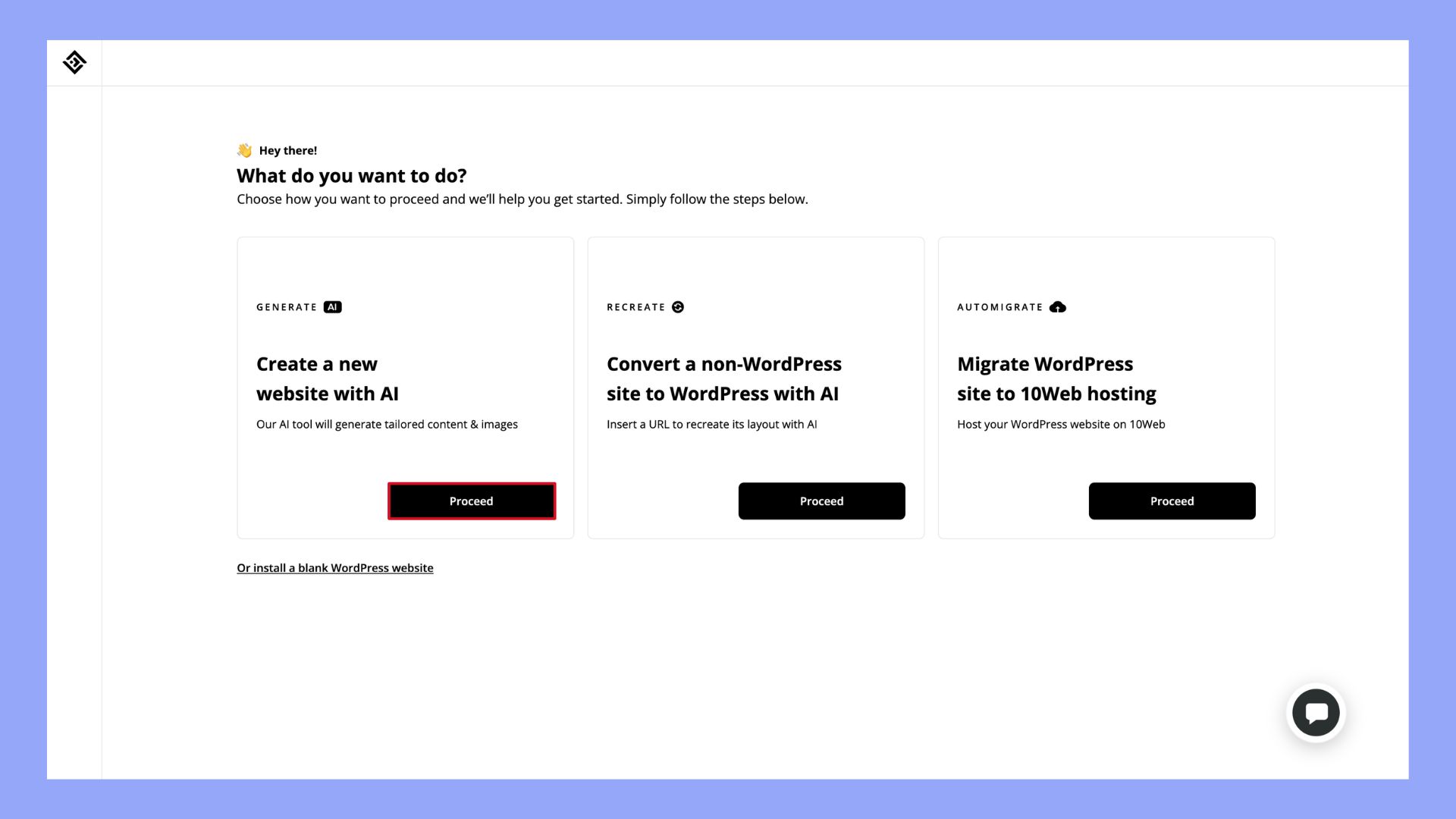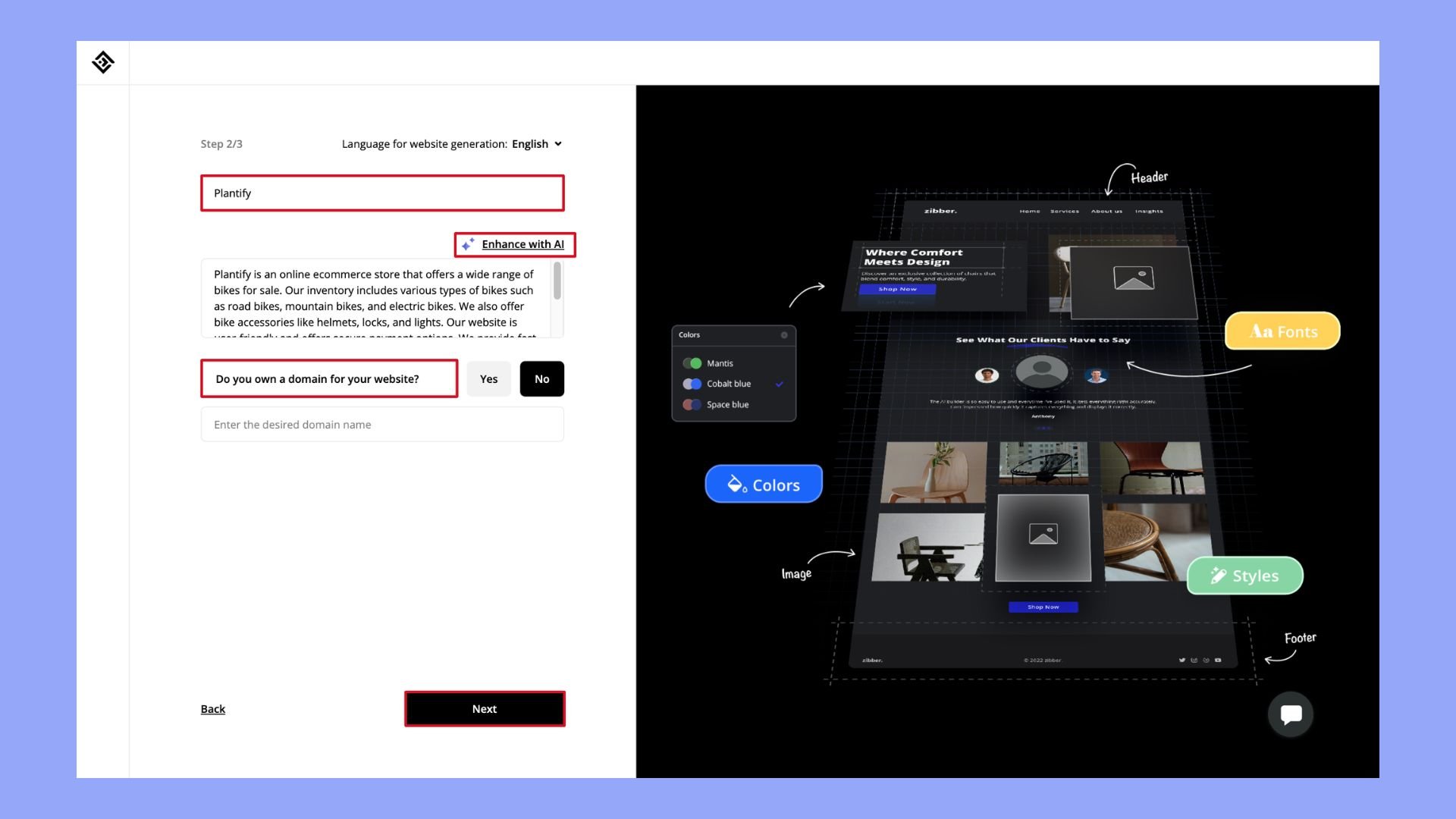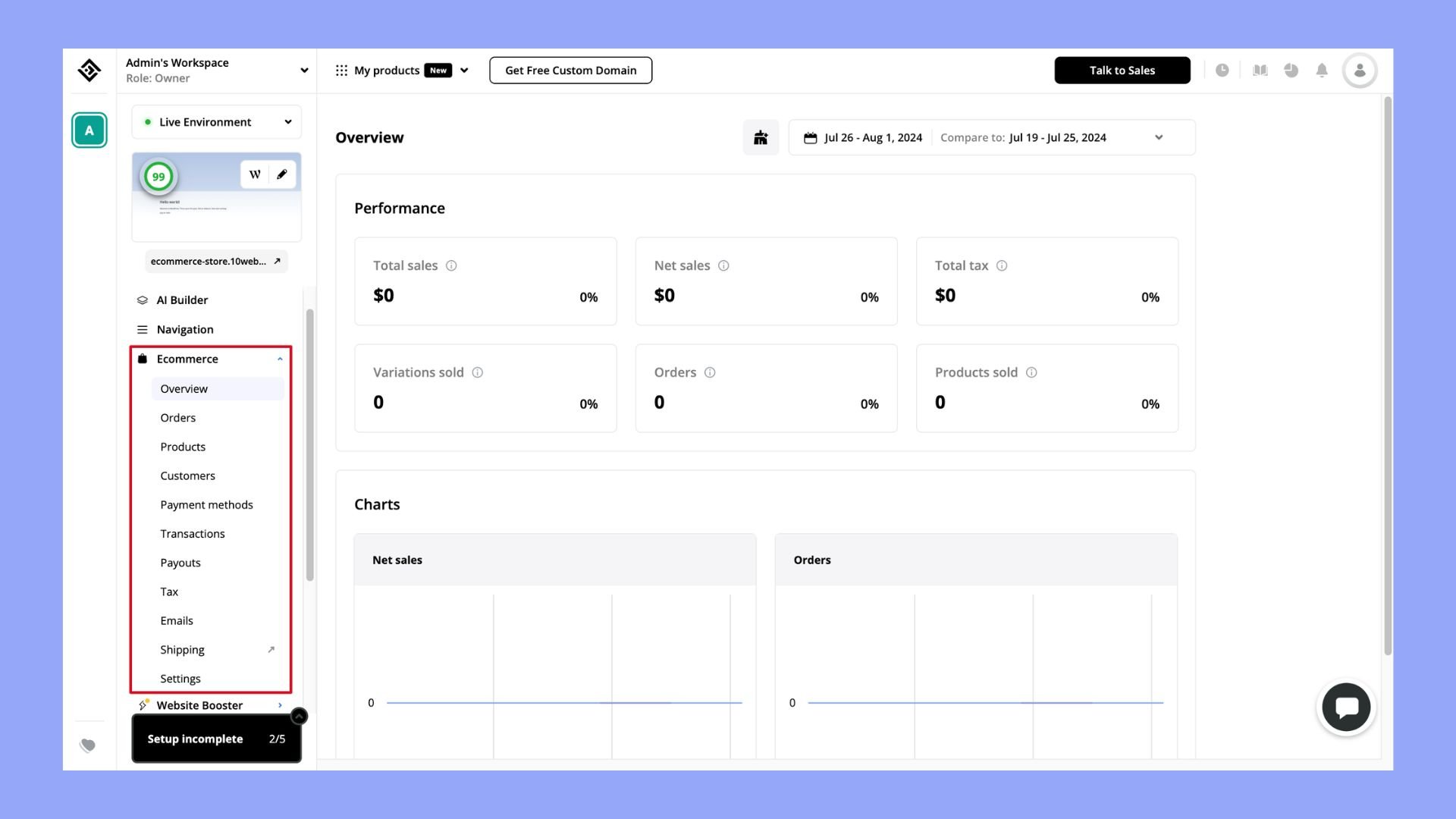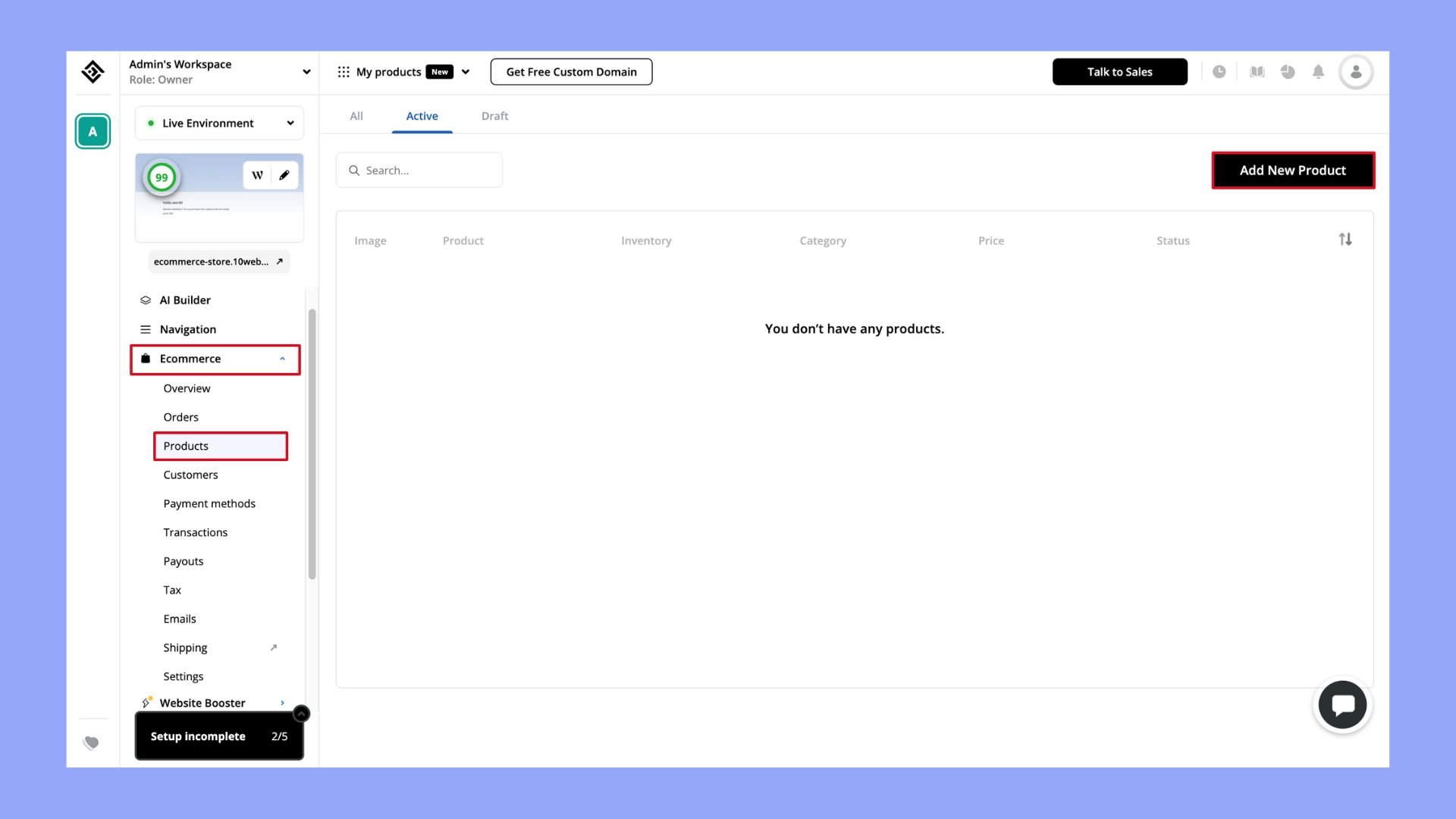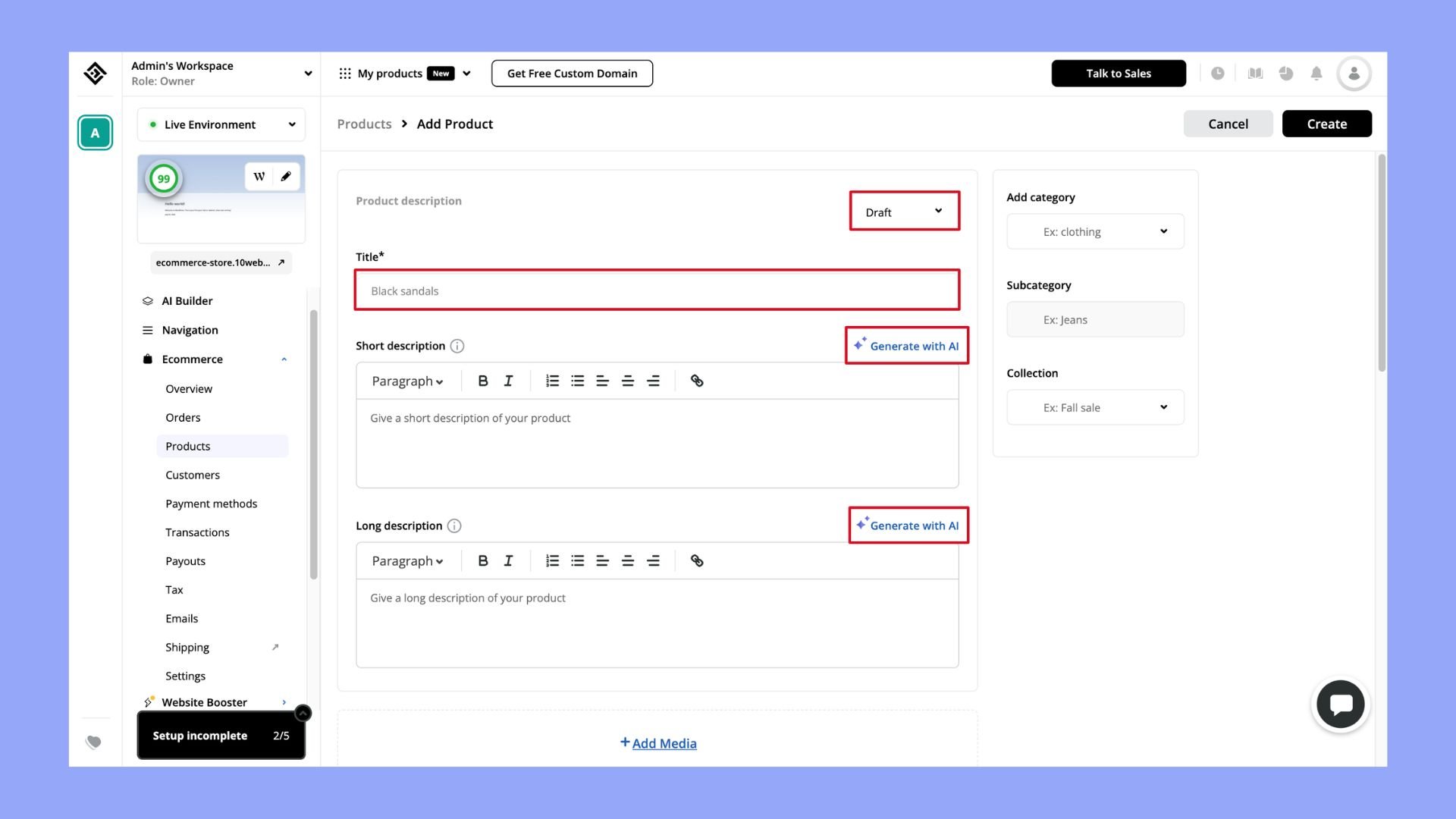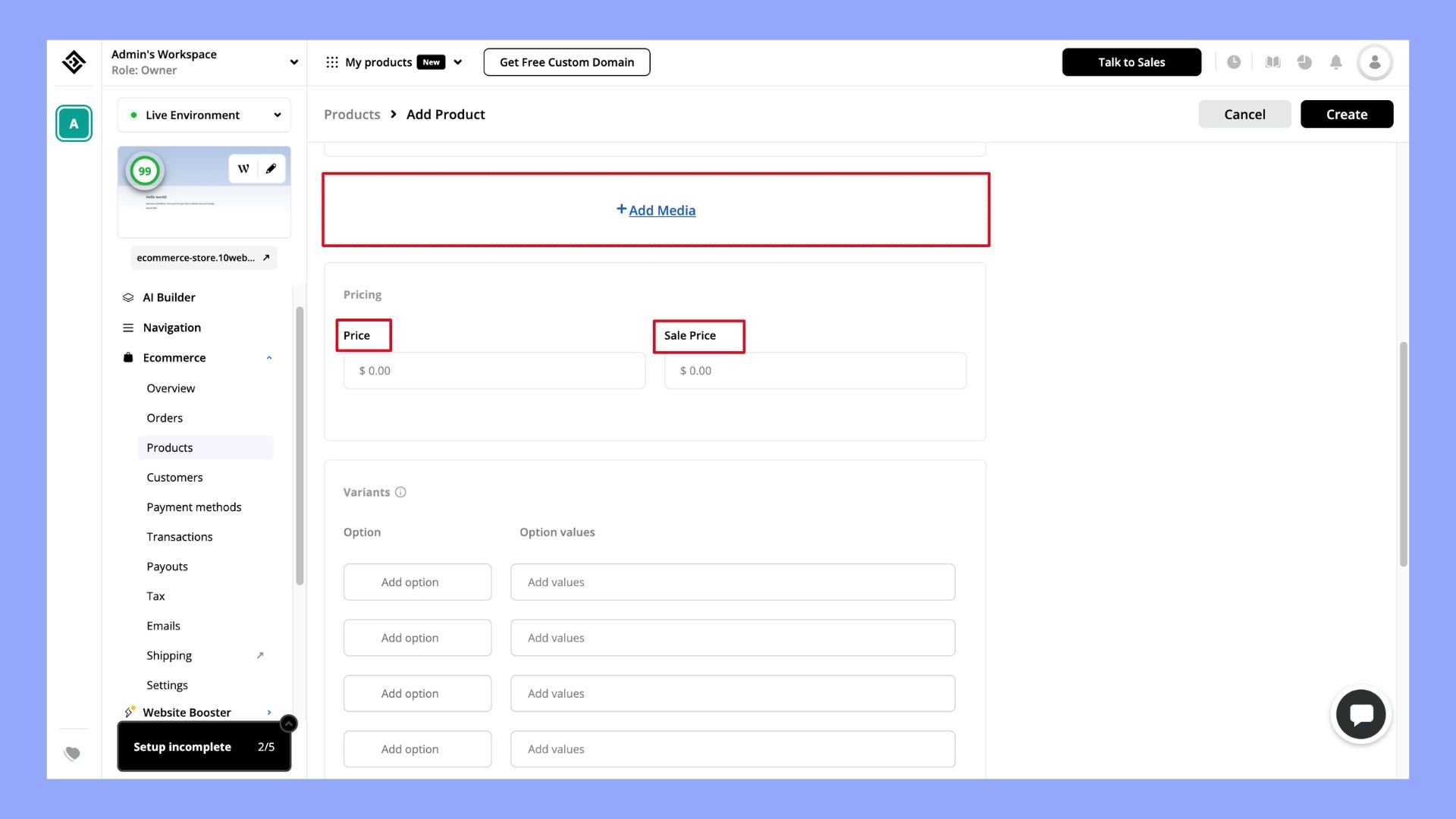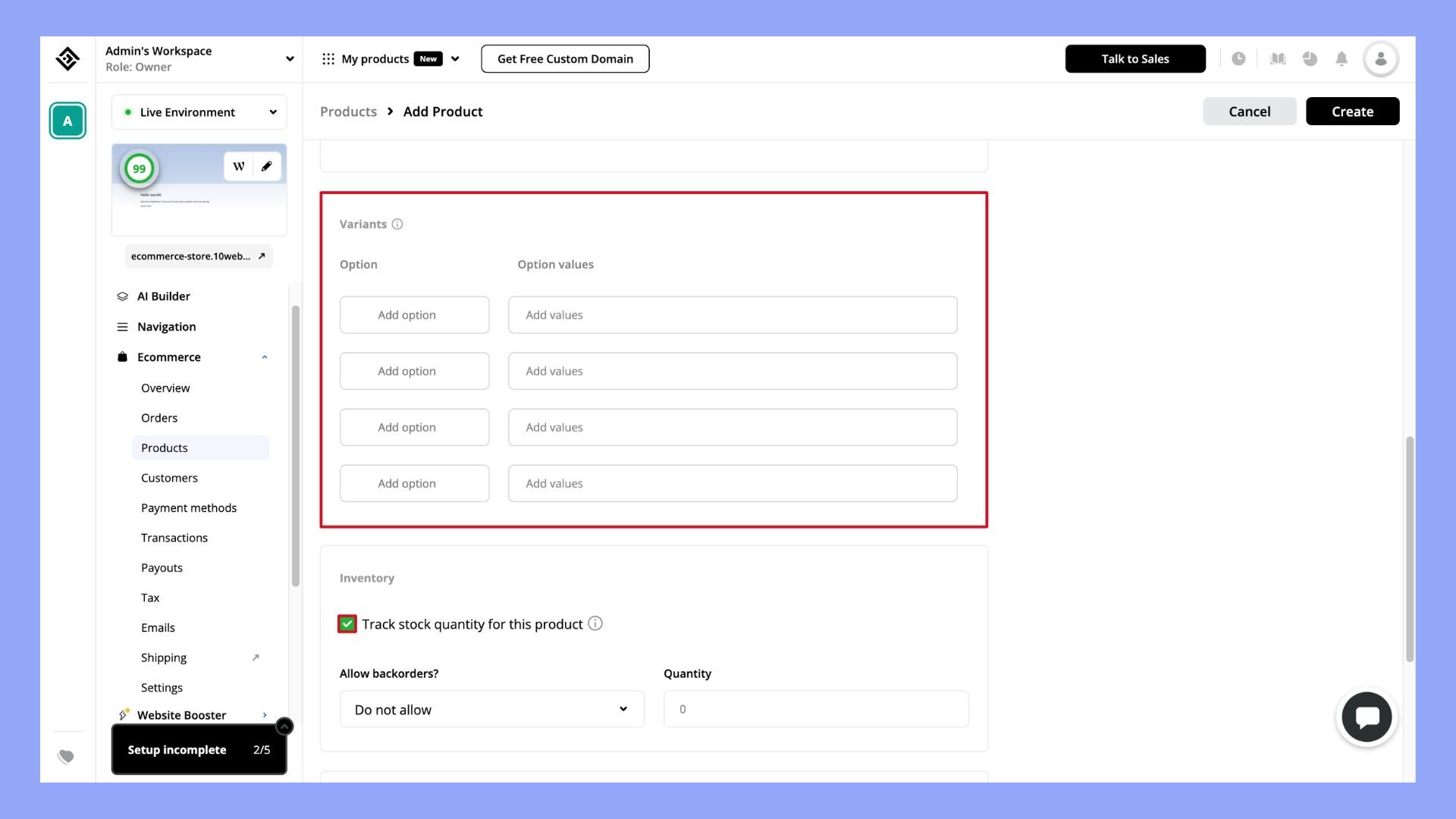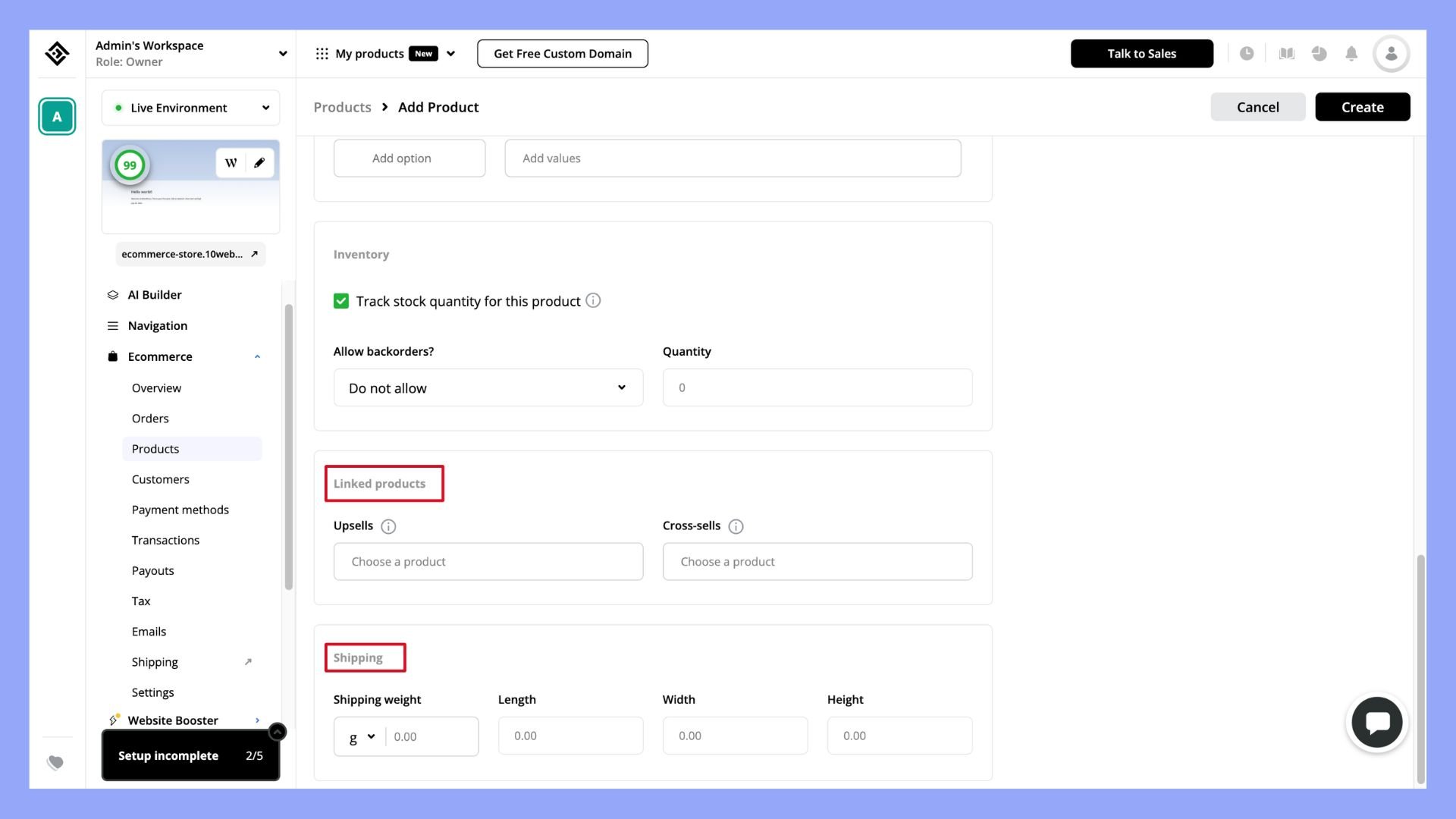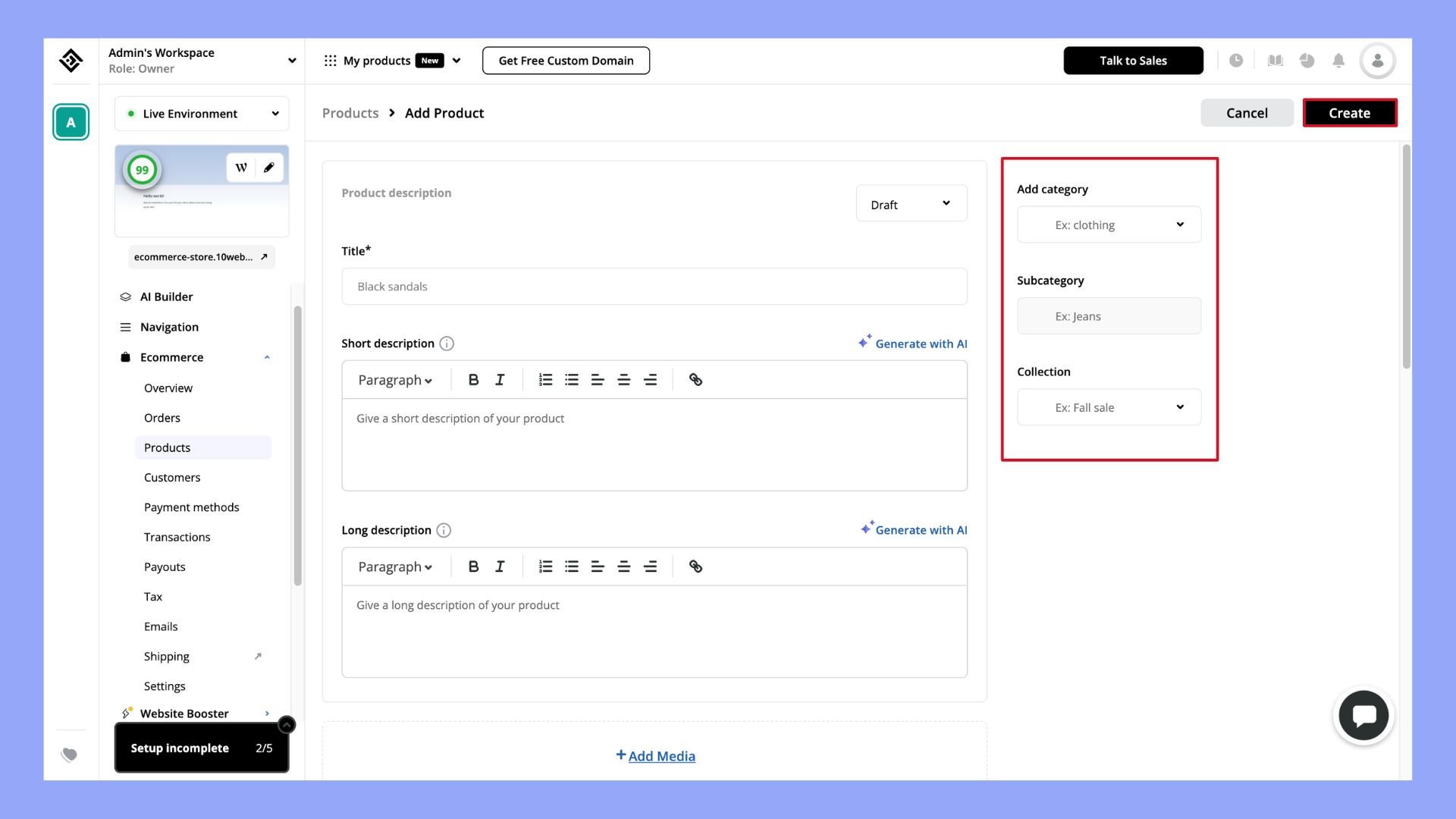The gardening industry has found a fertile ground online, providing plant enthusiasts and entrepreneurs with a unique opportunity to cultivate a thriving business. Selling plants online combines the joys of horticulture with the vast reach of ecommerce, enabling sellers to connect with a diverse customer base across regions. This article will cover essential tips and strategies to help you successfully sell plants online, ensuring your business flourishes. The excitement and potential in this sector are immense, as it allows for innovative marketing approaches, personalized customer experiences, and the satisfaction of spreading green spaces globally.
FAQ
Is it profitable to sell plants online?
Can I sell plants I grow at home?
How can I make money from my plants?
Can you sell plants on eBay?

Looking to sell online?
Create your custom online store in minutes with 10Web AI Ecommerce Website Builder and take your business online.
Current online plants selling market
The market for selling plants online is growing steadily. It includes trends, financial projections, and specialized segments like cacti, houseplants, and herbs.
Trends within the market
Online plant sales have surged, driven by the ease of ecommerce and an interest in home decor. Houseplants, like succulents and cacti, are popular due to their low maintenance. Plant lovers are also showing interest in herbs and growing their own plants at home.
The COVID-19 pandemic increased demand as people spent more time at home. This led to a rise in natural light setups, grow lights, and trays for indoor gardening. The trend of making spaces green and cozy remains strong.
Financial projections of the market
The market for online plant nurseries was valued at USD 9099.04 million in 2021 and is anticipated to grow significantly. By 2032, it could reach USD 32112.56 million, with a CAGR of 12.15%.
These projections highlight opportunities for expanding your online plant shop. Sellers can benefit from the trend, specifically those focusing on unique plant varieties, plant care products, and gardening accessories like fertilizers and soil.
Specialized segments of the market
The market for online plant sales includes diverse and specialized segments.
- Houseplants: Popular for home decor, easy to maintain.
- Succulents and cacti: Favored for their durability and aesthetic appeal.
- Herbs: Targets those interested in cooking and natural remedies.
- Seeds and bulbs: For gardeners who prefer to start plants from scratch.
- Greenhouses and grow lights: Essential for dedicated plant growers.
These segments cater to various preferences, making it important to provide detailed product information and excellent customer service. Your ability to tap into these niches can set your online plant business apart.

Looking to sell online?
Create your custom online store in minutes with 10Web AI Ecommerce Website Builder and take your business online.
How to sell plants online
Starting an online plant business involves creating a unique brand, conducting market research, planning, and choosing the right platform to sell plants. This guide will walk you through these critical steps.
Creating your brand
Creating a strong brand is essential for your online plant store. It’s not just about having a logo; it’s about creating an identity that resonates with your target audience. Think about what makes your plant business unique – whether it’s the types of plants you sell, eco-friendly packaging, or exceptional customer service.
On the other hand, you will need to pay closer attention to what brand name you choose for your business. To find the best and most memorable brand name you can use the 10Web Free Business Name Generator that will give you unique business names based on the description of your business. Simultaneously, you will be able to check the availability and price of a domain name you want.
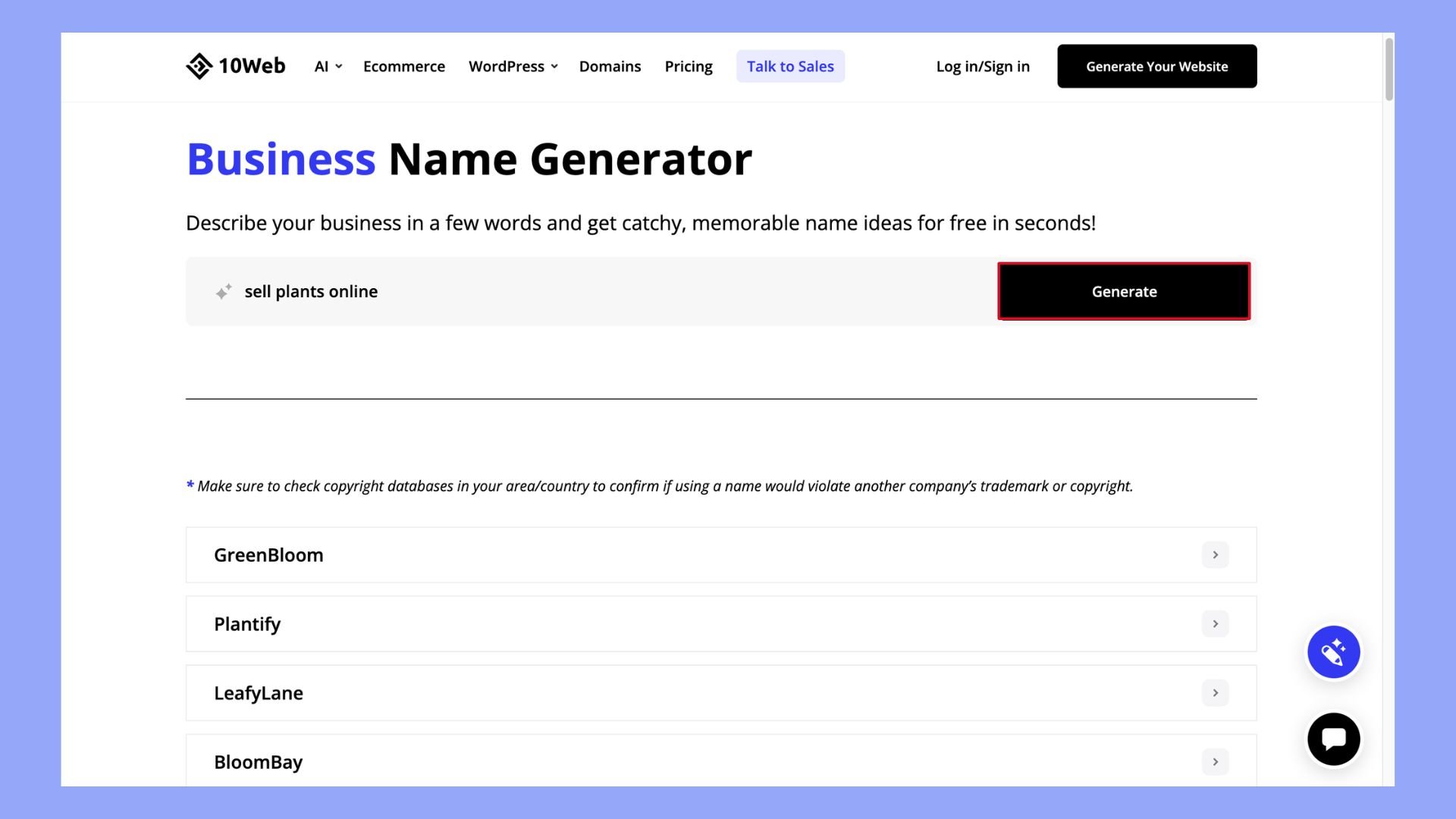
Choose colors, fonts, and a memorable logo that reflects your brand story. Consistency in branding across all platforms builds trust and recognition. Develop a compelling brand story that explains your passion and mission in the plant industry.
Vision
Your vision sets the direction for your online plant business. This includes your short-term and long-term goals. Define what you hope to achieve in the first year and your 5-year growth plan. For instance, you may aim to start with a small selection of indoor plants and expand to outdoor varieties.
Articulate your vision clearly to attract investors and customers. Highlight your commitment to quality, ethical sourcing, and sustainability practices. A clear vision helps in decision-making and maintaining focus on your objectives.
Market research
Market research is vital for understanding your competition and identifying what your target audience wants. Look at successful online plant stores and study their products, pricing strategies, and customer reviews. Tools like Google Trends can help you understand plant buying trends and seasonality.
Identify potential gaps in the market that you can fill. For example, maybe there’s a rising interest in hanging planters or terrariums. Analyzing your competitors’ strengths and weaknesses gives you insights into how to differentiate your business.
Writing a business plan
A business plan maps out the steps to achieve your goals. Start with an executive summary that provides an overview of your plant business. Include a detailed market analysis, outlining your target market and competitive analysis.
Your plan should cover operations, inventory management, and logistics. Describe your pricing strategy, considering fixed costs and profit margins. Detail your marketing plan, including how you’ll use social media, SEO, and email marketing to reach your audience.
Best platforms for selling plants online
Choosing the right platform is crucial for your success. You can opt for ecommerce platforms like 10Web to build your own store. Alternatively, you can sell on established marketplaces like eBay and Etsy, which offer access to a large customer base but come with fees. Social selling platforms such as Instagram and Facebook enable you to sell directly through social media, tapping into your followers.
5 best places to sell plants online
- Plantly: Plantly is an online and mobile plant marketplace that connects plant lovers with independent micro nurseries and side hustlers. With Plantly, you gain access to a ready-built marketplace with a community of hobbyists, gardeners, and all plant lovers selling and buying high-quality plants. Plantly offers both iOS and Android mobile apps, allowing a wide range of customers to browse and shop for plants.
- Etsy: Etsy is an online marketplace that specializes in handmade and unique items, making it an excellent platform for selling plants and plant-related products. Etsy is an incredibly popular platform that can give you a chance to sell to environmentally-conscious customers and those who appreciate the artistry and care that goes into each plant.
- Amazon Marketplace: Amazon is one of the largest and most widely recognized ecommerce marketplaces globally, making it an excellent choice for selling plants online. The platform’s established reputation for reliability and convenience gives you access to a broad international audience. Amazon also offers excellent order fulfillment services that allow you to sell your plants with ease.
- eBay: eBay is one of the leading marketplaces that facilitate the sale of goods between third-party buyers and sellers. Since it is an established global platform, eBay allows you to sell directly to a global customer base. Selling plants on eBay can be lucrative, especially if you can offer unique or rare plant varieties.
- PlantOgram: PlantOgram is an online marketplace that specializes in selling exotic and tropical species of plants. By listing your plants on PlantOGram, you can tap into a niche community of buyers who are passionate about collecting and cultivating unique and specialty plant varieties.
6 tips to successfully sell plants in an online marketplace
- Accurate plant descriptions: Provide detailed descriptions of each plant, including its species, size, growth conditions, care requirements, and any special features. Accurate descriptions help customers make informed decisions and reduce the likelihood of returns.
- Competitive and transparent pricing: Set competitive prices while being mindful of factors such as plant size, rarity, and overall quality. Offering fair pricing helps attract value-seeking customers.
- Packaging and shipping: Develop a robust packaging strategy with options for tracking and expedited shipping for live plants to ensure that plants arrive in good condition. Ensure that appropriate containers, padding, and labels are always used.
- Transparent plant condition: Honesty builds trust with customers. If a plant has any issues or imperfections, clearly communicate them in the product description.
- Responsive customer support: Provide responsive and helpful customer support. Address inquiries promptly and courteously. Communicate with customers throughout the purchasing process and after delivery to ensure their satisfaction.
- Customer reviews and testimonials: Encourage satisfied customers to leave reviews and testimonials on your online marketplace profile. Positive feedback builds trust and credibility, and it can significantly influence potential buyers.
Reasons to set up your own ecommerce store
There are many established marketplaces where you can easily sell your plants. Why would you need to set up a store when you can just learn how to sell plants online through these platforms?
While selling your plants through third-party sales channels is convenient, they come with tremendous risks, especially if they’re the only sales channel.
Here are other compelling reasons why the best place to sell plants online is on your own online store:
- Brand control: Establishing your store gives you full creative control over how you present your business. This allows you to create a unique and memorable brand that customers instantly recognize.
- Allows customers to focus on products: Unlike marketplaces where customers can view products from your competitors, customers who visit your store only interact with your plants.
- Direct and personalized communication: Direct communication and interactions with existing and potential customers allow you to build strong relationships, offer dedicated support, and get feedback directly.
- Full access to customer data: Third-party online platforms often retain rights to customer data on their platforms, allowing access to only some of it. However, with your online plant store, you have full ownership over customer data.
- Avoid race to the bottom: Setting up your own store can save you price wars with other sellers on marketplaces and improve your profit margins.
Creating a website with 10Web
We hope you’re now convinced that selling plants on your own website is not only a great idea but also the best platform to showcase your talent. Here’s a step-by-step guide to creating your website using the 10Web AI Website Builder.
- Visit the 10Web.io page.
- Click on Generate Your Website.

- Proceed with the option to Create a website with AI.

- Select the type of store you want to create.

- Enter the name of your store or business and provide a brief description of your online art business. You can also add a few keywords about your website and click Enhance with AI to turn them into a compelling description.
- If you already own a domain name, select Yes when asked. If not, select No, enter a desired domain name, and click Next.

- Enter the names of the three art products you’ll be selling on your online store along with their categories, and click Generate.

Allow the 10Web AI Website Builder to generate your website, which may take a minute or two. Once ready, click the Preview and Edit button to view your website.
Your art website is now complete with pre-populated content and images based on the information and description you provided. The site includes sections such as the Homepage, About Us, Sale, and Shop, allowing visitors to explore different art categories.
Select a hosting platform
After finalizing the design of your ecommerce store, the next step is to select a hosting provider for your site. For a reliable hosting provider that fits your needs and budget, 10Web’s Managed WordPress Hosting is an excellent choice. This service offers a fully automated hosting solution, high-performance infrastructure, free SSL certificates, real-time backups, an intuitive dashboard, and 24/7 live chat support.
What you’ll get by using 10Web
With the 10Web Ecommerce plan, you’ll gain access to a range of features including an overview of sales, taxes, net sales, and more. Here is a list of pages available to 10Web ecommerce users, designed to help you efficiently manage your website and business:
| Page | Description |
| Orders | Manage and track orders. |
| Products | Add, edit, and organize products in your store. |
| Customers | View and manage customer information. |
| Payment methods | Set up and manage payment options for your store. |
| Transactions | Track and review transaction details. |
| Payouts | Manage and track payouts to your account. |
| Tax | Configure and manage tax settings and information. |
| Emails | Set up and manage email notifications and communications. |
| Shipping | Configure and manage shipping options and settings. |
How to add the plants you want to sell
10Web’s interface makes it easy and quick to add products to your ecommerce store. Here’s a step-by-step guide:
- Go to your 10Web dashboard.

- Select the Ecommerce option from the menu on the left, then click on Products.
- Click on Add New Product.

- Choose whether you want the product to be Active or just a Draft.
- Enter the product title.
- Provide short and long descriptions for the product. Enhance these descriptions using the Generate with AI tool.

- Upload high-quality images of the product. You can add multiple images to give customers a better view of the product.
- Set the price, and include a sale price if applicable.

- Add product Variants to offer customers different options.
- Enable Track stock quantity to automate stock management.

- Include linked products and shipping details.

- Select the category, sub-category, and collection from the options in the top right corner.
- Once all the details are complete, click Create to add the new product to your website.

6 tips to promote and grow your online plant store
Online businesses operate in a very dynamic and competitive environment. Therefore, part of learning how to sell plants online should include how you can continually promote your online plant store. The tips below can help you keep your online plant business ahead of the competition:
- Optimize your site for content for SEO: Implement effective SEO strategies to improve your site’s ranking on search engine results pages. You can do this by optimizing content, product descriptions, titles, and meta tags with keywords relevant to the plant industry.
- Customer testimonials and reviews: Encourage customers who have liked your plant products to leave good reviews on your website, social media pages, and platforms such as Google and TrustPilot. Positive reviews build customer trust and credibility, encouraging potential customers to purchase your products.
- Build and nurture an email list of past and potential customers: An email list allows you to stay in touch with your customers through newsletters, blog content, product updates, occasional promotions, and other things that might encourage them to take action.
- Create valuable content: Creating insightful content is the best way to drive traffic to your online plant website and place your brand as an authoritative voice in your niche. You can share content via blog posts, videos, articles, and infographics.
- Run contests and rewards programs: You should implement a reward program for loyal customers to increase customer engagement. For instance, you can offer points, discounts, or free products. This can boost customer loyalty and encourage repeat purchases.
- Collaborate with local businesses and the community: Strategic local partnerships can help elevate brand awareness, increase your revenues, and allow you to reach new customers.

Looking to sell online?
Create your custom online store in minutes with 10Web AI Ecommerce Website Builder and take your business online.
Marketing and customer engagement
If you want to succeed in selling plants online, you need to use effective marketing strategies and engage your customers regularly. Here’s how you can reach your target audience and keep them interested in your products.
Diverse methods to effectively connect with your audience
To connect with your audience, use different methods to reach them where they are. Email newsletters are great for sharing updates on new plants and special promotions. Social media platforms like Facebook and Instagram let you connect with customers through posts, stories, and ads.
Google Trends can help you discover popular plant types and new trends in the plant market. Charitable partnerships can also attract customers who appreciate businesses that give back.
Content marketing
Content marketing is a powerful way to engage your customers. Share useful plant care tips through blog posts, infographics, or videos on your website. This not only attracts visitors but also establishes you as an authority in the plant industry. Create content that answers common questions about growing and maintaining plants.
Product photos are crucial. Invest in high-quality product photography to showcase your plants. Include close-up shots, 3D photography, and images of plants in different settings to give customers a clear idea of what they are buying.
Social media
Social media is essential for marketing your online plant store. Create accounts on platforms such as Instagram and Facebook and post regularly. Use hashtags to increase your posts’ visibility. Share images and videos of your plants, including how you package and ship them safely.
Run contests and giveaways to attract more followers. Engage with your audience by responding to comments and messages promptly. Track your performance with analytics to see which posts get the most engagement and why.
Interactive content and blog posts
Interactive content keeps your audience engaged and coming back for more. Create polls, quizzes, and surveys about plants. Ask questions like Which plant suits your home style? or What’s your favorite way to display plants?
Write blog posts regularly to provide valuable information. Share plant care tips, news about the latest plant trends, and updates about your store. Embed videos and images to make your posts more engaging.
Adding sections for customer reviews can also boost trust and showcase real-life experiences with your plants. This helps potential buyers shop with confidence.
Conclusion
Selling plants online offers a dynamic and rewarding venture for those passionate about horticulture and eager to embrace the digital marketplace. By implementing the tips and strategies discussed, you can nurture a successful online plant business that not only thrives financially but also brings joy to customers by enhancing their green spaces. Embrace the opportunities this blooming industry presents, and watch your business grow and flourish in the ever-expanding online world.



